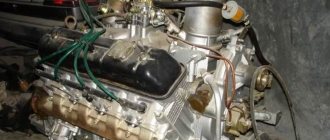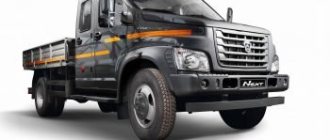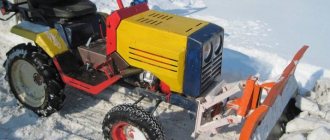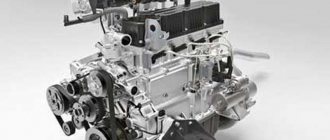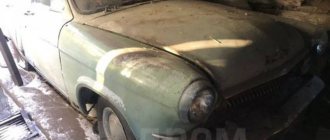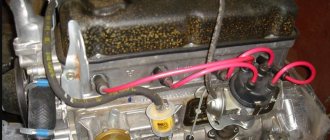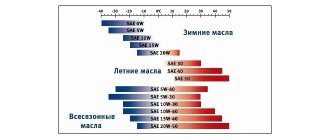Oil selection
The manufacturer recommends using motor oils that have the following indicators according to the SAE standard, which determines the fluidity (viscosity) of a lubricant:
It is advisable to fill the engine with mineral or semi-synthetic oil from Russian and foreign manufacturers. When using more liquid or synthetic ones, you may encounter leakage through the seals or gaskets.
Important: mineral oil should only be used in the summer. In winter, you need to fill in “semi-synthetic”, which thickens less in the cold.
Design
Four-stroke four-cylinder gasoline carburetor with a contact ignition distributor, with an in-line arrangement of cylinders and pistons rotating one common crankshaft, with a lower camshaft. The engine has a closed-type liquid cooling system with forced circulation. Lubrication system - under pressure and splashing. Aluminum cylinder block with wet cast iron liners. Aluminum pistons. Eight-valve cylinder head, cast aluminum. The valves are equipped with a single spring and are actuated via rocker arms.
Preparation
The oil has sufficient fluidity only after the engine has warmed up to operating temperature. Replacing on a cold engine leads to a lot of old dirty oil remaining in the system. Therefore, before replacing, you need to start the engine and wait until the coolant temperature sensor reaches 80 degrees.
Changing the type of lubricant (switching from mineral water to synthetic or vice versa) requires mandatory flushing of the system. For this purpose, special detergent additives or oils are used. To quickly flush, just pour a special product into a warm engine and let it run at idle for 10-15 minutes.
In cases where it is necessary to clean oil channels and engine parts from carbon deposits and other contaminants, gentle flushing is used. It takes more time - to clean it you need to fill it with liquid and drive 100-150 kilometers.
Procedure for changing oil
The car with a warm engine must be placed on a pit or overpass and wheel chocks must be placed under the wheels. Changing the oil in the ZMZ 402 engine is performed as follows:
- unscrew the bolts securing the crankcase protection (if any);
- remove the protection plate;
- open the filler neck on the motor head;
- place a container for used oil under the drain hole in the engine sump;
- Use a 24 mm wrench to unscrew the drain plug;
- wait until the oil drains completely from the crankcase;
- Using a 14mm wrench, unscrew the bolt securing the oil filter cover;
- remove the cover and remove the filter element;
- wipe the lid and filter housing with a rag;
- install a new gasket and filter element;
- close the filter cover and tighten the fastening bolt;
- wipe the plug and crankcase around the oil drain hole with a rag;
- install a new gasket on the plug;
- tighten the oil drain plug;
- secure the crankcase protection and tighten the bolts;
- using a funnel, pour 5 liters of oil into the engine;
- wait until the oil drains into the pan;
- check the level with a dipstick;
- start the engine and wait until the oil pressure light goes out;
- turn off the engine;
- make sure there are no leaks in the area of the oil drain plug and oil filter cover;
- check the oil level and add it if necessary;
- fill the oil filler cap
At this point, the oil change in the ZMZ 402 engine is completed and the machine is ready for operation.
Design Features
In comparison with the “zero” prototype, the ZMZ 402 engine received very minor design improvements, since the task was not to increase power:
- Initially, the cylinder block was cast in a mold, the cylinder liners were fixed in the boring of the upper plate, along the upper shoulder;
- then the plant management switched to injection molding technology, the top jacket became open, the sleeves were attached inside the bottom belt;
- Later, the manufacturer returned to die casting again, so both blocks are used in the machines.
Disassembled motor
Another feature of the power drive is the use of an oil cooler to make the cooling system work more efficiently.
Oil radiator
The gas distribution mechanism has a morally outdated OHV scheme already at the time of the creation of the internal combustion engine - a camshaft from below, control of a rocker-rod mechanism. It is because of this unit that the engine turned out to be very heavy, despite the light cylinder block.
Engine ZMZ-402
ZMZ-402 engines are unpretentious in operation and quite easy to maintain. These are gasoline, carburetor, 4-cylinder in-line engines. They were installed mainly on Volga and Gazelle cars. Over the years of production, 6,125,136 copies of the engine were produced.
Modifications of the ZMZ 402 series engine:
- ZMZ-402.10 as the main basic option for AI-92 gasoline;
- ZMZ-4021.10, consuming A-76 fuel (80);
- ZMZ-4022.10, which has a new type of ignition, the so-called pre-chamber-torch;
- ZMZ-4025.10 - designed for cars of the Gazelle family (same 4021.10);
- ZMZ-4026.10 - designed for cars of the Gazelle family (same 402.10).
Specifications
* - for engines ZMZ 4021.10 and 4025.10 ** - engine weight for Gazelle
Maintenance ZMZ-402
- The engine oil is changed every 10 thousand km. Engine oil volume is 6 liters. When replacing along with the oil filter, you will need about 5.8 liters. The oil is suitable for SAE 5W-30, 5W-40, 10W-30, 10W-40, 15W-40 (many car owners recommend using semi-synthetic oil, and the use of liquid oils and synthetics leads to unnecessary leaks).
- It is necessary to adjust the gaps every 15 thousand km. For exhaust valves, the normal thermal gap is in the range of 0.4 - 0.45 mm. For the intake valves of the first and fourth cylinders - 0.35 - 0.4 mm. The valve clearance of the second and third cylinders is 0.4 - 0.45 mm.
View of ZMZ-402 on the left: 1 – starter; 2 – starter traction relay; 3 – oil line; 4 – fuel pump; 5 – engine support bracket; 6 – sensor for emergency oil pressure lamp; 7 – oil filter; 8 – crankshaft pulley; 9 – water pump pulley; 10 – water pump; 11 – thermostat; 12 – coolant temperature indicator sensor; 13 – fine fuel filter; 14 – spark plug; 15 – ignition distributor; 16 – pusher cover; 17 – ignition distribution drive and oil pump.
View of ZMZ-402 on the right: 1 – crankshaft pulley; 2 – oil pressure indicator sensor; 3 – exhaust manifold; 4 – oil sump; 5 – coolant drain valve; 6 – cylinder head; 7 – inlet pipe; 8 – carburetor; 9 – oil filler plug; 10 – rocker cover; 11 – thermostat; 12 – water pump pulley; 13 – generator.
Engine GAZ ZMZ 402 2.45 l/100 l. With
The ZMZ 402 engine was designed from the 24D engine in the 70s, the prototype of which was used in the GAZ-56 and GAZ-21 semi-trucks. Initially, it was all-aluminum, with timing rods and rocker arms and a lower camshaft. The crankshaft was sealed with a harness soaked in graphite lubricant, and not with a full-fledged rubber product.
Technical characteristics of ZMZ 402
The engine uses a simple, primitive old design with an OHV gas distribution mechanism, paranitic and asbestos gaskets, an aluminum block, a head and its cover, and cast iron intake and exhaust manifolds.
The main technical characteristics of the ZMZ 402 are as follows:
| Engine brand | 402 |
| Years of production | 1981 – 2006 |
| Volume | 2445 cm3 (2.45 l) |
| Power | 73.5 kW (100 hp) |
| Torque moment | 182 Nm (at 2500 rpm) |
| Weight | 181 – 184 kg |
| Compression ratio | 8,2 (7,6) |
| Nutrition | carburetor, multipoint injection |
| Motor type | in-line, petrol, 4 cylinder |
| Ignition | switching, contactless |
| Number of cylinders | 4 |
| Location of the first cylinder | TVE |
| Number of valves on each cylinder | 2 |
| Cylinder head material | aluminum alloy |
| Intake manifold | duralumin |
| An exhaust manifold | cast iron |
| Camshaft | original cam profile |
| Cylinder block material | resin impregnated aluminum alloy |
| Cylinder diameter | 92 mm |
| Pistons | original |
| Crankshaft | from 2103 |
| Piston stroke | 92 mm |
| Fuel | A-76, AI-92 |
| Environmental standards | Euro-0 |
| Fuel consumption | highway – 5.3 l/100 km mixed cycle 6.6 l/100 km city – 13.5 l/100 km |
| Oil consumption | maximum 0.2 l/1000 km |
| What kind of oil to pour into the engine by viscosity | 5W30, 10W30, 5W40, 0W30, 0W40 |
| Which engine oil is best by manufacturer | Liqui Moly, LukOil, Rosneft |
| Oil for ZMZ 402 composition | synthetics, semi-synthetics, mineral |
| Engine oil volume | 6 l |
| Operating temperature | 80 – 110° |
| ICE resource | declared 200,000 km actual 250,000 km |
| Adjustment of valves | adjusting screws + feeler gauges |
| Cooling system | forced, antifreeze |
| Coolant volume | 3.5 l excluding hoses, heater and radiator |
| water pump | with plastic impeller |
| Thermostat | two-valve TA107-05 or TS107-05 |
| Spark plugs for ZMZ 402 | Czech Brisk DR17YC/A |
| Spark plug gap | 0.7 – 0.85 mm |
| Timing gear | Gates, width 22 mm, service life 200,000 km |
| Cylinder operating order | 1-3-4-2 |
| Air filter | Nitto, Knecht, Fram, WIX, Hengst, replaceable cartridge |
| Oil filter | Mannol SCT SH415, Mann H727/4 |
| Flywheel | diameter 330 mm, weight 13.2 kg |
| Flywheel mounting bolts | M12x1.25 mm, length 26 mm |
| Valve stem seals | — |
| Compression | from 7 bar, difference in adjacent cylinders maximum 1 bar |
| XX speed | 800 – 850 min-1 |
| Tightening force of threaded connections | spark plug – 31 – 39 Nm flywheel – 62 – 87 Nm clutch bolt – 19 – 30 Nm bearing cover – 68 – 84 Nm (main) and 43 – 53 (connecting rod) cylinder head – three stages 20 Nm, 69 – 85 Nm + 90° + 90 ° |
The table provides a description of the base motor, which is suitable for all variants of this series.
Design Features
In comparison with the “zero” prototype, the ZMZ 402 engine received very minor design improvements, since the task was not to increase power:
- Initially, the cylinder block was cast in a mold, the cylinder liners were fixed in the boring of the upper plate, along the upper shoulder;
- then the plant management switched to injection molding technology, the top jacket became open, the sleeves were attached inside the bottom belt;
- Later, the manufacturer returned to die casting again, so both blocks are used in the machines.
The gas distribution mechanism has a morally outdated OHV scheme already at the time of the creation of the internal combustion engine - a camshaft from below, control of a rocker-rod mechanism. It is because of this unit that the engine turned out to be very heavy, despite the light cylinder block.
List of internal combustion engine modifications
The ZMZ 402 marking is a whole family of single-row 4-cylinder engines, which includes modifications:
- 10 – basic version with a compression ratio of 8.2 for AI-92 fuel for the Volga car;
Advantages and disadvantages
The main disadvantages of the ZMZ 402 engine series are:
- obsolete timing belt design;
- the cylinder head makes tuning difficult;
- very weak gaskets and rear crankshaft oil seal;
- high vibrations leading to loosening of threaded connections.
On the other hand, the motor is very reliable and designed for high operating loads. With normal maintenance, the actual service life is 300 - 350 thousand km.
List of car models in which it was installed
The ZMZ 402 motor was created for the Gorky and Ulyanovsk Automobile Plants, the Riga Bus Factory, and therefore was used to complete cars:
- GAZ-24-10 Volga – 1985 – 1993;
- GAZ-3102 Volga – 1981 – 2006, only pre-chamber modifications of the internal combustion engine;
- GAZ-31029 Volga – 1992 – 1997;
- GAZ-3110 Volga – 1997 – 2005;
- GAZ-31105 Volga – 2002 – 2006;
- GAZ-3302 Gazelle – 1994 – 2003;
- GAZ-33023 Gazelle-Farmer – 1995 – 2003;
- GAZ-2705 Gazelle cargo-passenger – 1995 – 2003;
- GAZ-3221 Gazelle minibus – 1996 – 2003;
- GAZ-32213 Gazelle luxury minibus – 1996 – 2003;
- GAZ-322132 Gazelle minibus (sliding door) – 1996 – 2003;
- GAZ-32214 Gazelle “ambulance” – 1996 – 2003;
- RAF-M1 Roxana and RAF-M2 Stills - released in a single copy, did not go into series;
- RAF-33111 – two-seater flatbed truck 1 ton;
- RAF-22038 – minibus, small production volumes;
- RAF-22039 is a large minibus.
Social (resuscitation and hearse) and school buses with power drive ZMZ 404 were assembled by the Semenovsky Automobile Repair Plant from 1995 to 2006. Some parts were used in UAZ engines as components.
Maintenance regulations ZMZ 402
The official manual contains terms for replacing consumables so that the ZMZ 402 engine lasts the entire declared service life:
- engine oil after 10,000 km;
- coolant after 60,000 km or 2 years of operation;
- adjustment of valve thermal clearances every 15,000 km;
- tightening the cylinder head nuts every 20,000 km;
- The air filter cartridge lasts 20,000 km, and the fuel filter 30,000 km.
Initially, the internal combustion engine device was equipped with very unreliable gaskets. A 1.5 mm thick asbestos sheet impregnated with graphite between the block and the head normally maintains the temperature, but vibrations weaken the nuts. The timing cover and oil pan are sealed with paranitic gaskets, which have a low service life and are oil resistant.
Timing gear drive
Review of faults and methods for repairing them
In principle, the ZMZ 402 motor was not fully developed from the very beginning, since at the time of its creation there were already more advanced technical solutions. The main advantage is safety when cutting the timing gear teeth - the piston does not bend the valve.
But the crankshaft is ground using a centerless method, radial runouts occur, and at speeds above 2500 - 2700 rpm, the rope rear oil seal cannot cope with the task. The exhaust goes into the crankcase and the oil pressure increases. The following malfunctions are typical for motors of the ZMZ 402 family:
| Oil leak | the gasket burns out due to stronger heating of the middle part of the cylinder head | gasket replacement and timely tightening |
| Motor overheating | breakdown of the pump, thermostat, air lock in the cooling system | replacing the pump/thermostat, removing the plug |
| Vibrations | imbalance of the ignition system, carburetor or flywheel, wear of pillows | balancing systems, replacing pillows |
Knocking can occur in crankshaft bearing shells and valves, but disappears after replacement.
Engine tuning options
In the factory configuration, the ZMZ 402 engine produces 182.4 Nm of torque and 100 hp. With. power, therefore, to increase these characteristics, several types of mechanical tuning can be used:
- boring of cylinders for liners - maximum 100 mm in diameter;
- cylinder head grinding – increases the compression ratio for using fuel with a high octane number AI-95;
- modernization of the exhaust tract - increasing the diameter of the exhaust pipe.
The first method is dangerous due to overheating of the power drive, since the thickness of the block walls is reduced by 4 mm; overhaul will be required faster. In the latter option, the environmental friendliness of the internal combustion engine is reduced. The manufacturer recommends either using injection, which is very expensive, or using simpler but less effective tuning:
- replacement of spark plugs with modifications with iridium contacts and high-voltage wires;
- lightweight camshaft with adjustable valve settings installed from the factory;
- replacing the K-151 manufacturer's carburetor with more recent versions, for example, Solex;
- use of lightweight ShPG and flywheel;
- boring valve seats and replacing them with modifications of larger diameter.
Thus, the ZMZ 402 motor is the base version of a whole series of engines 402.10, 4021.10, 4022.10, 1025.10 and 4026.10. Initially, until 1980, it was labeled ZMZ-24D and was installed on the Volga, Gazelle and RAF.
Don't forget to share this page with your friends and subscribe to our group
How much oil is in a 402 engine
At first the dipstick showed exactly half, which is what I expected, but then the oil level inexorably climbed up! Now about 1.5cm above max. From five liters? Well, it shouldn’t be higher than max. What did you do with the filter? Did you change the element? Was the old oil removed from the glass when replacing it? When you installed the new one, did you pour something fresh into the glass?
After pouring oil into the cylinder head, it should drain into the crankcase, don’t forget this fact!
In the garages they advised to drain the oil a little and measure the level during operation. If the crankshaft is spinning, there is no need to drain anything. Nothing bad will happen.
The oil pressure lamp will blink at idle on a hot engine. This is not scary, it is allowed.
By the way, yes! Once upon a time I bought a Moskvich 2141 with an engine from the 412. When I changed the oil, I couldn’t understand anything. It turns out that the dipstick from some kind of jig was there to simply plug the hole. I had to put new risks on the dipstick myself.
Added after 11 minutes 53 seconds From five liters? Well, it shouldn’t be higher than max. What did you do with the filter? Did you change the element? Was the old oil removed from the glass when replacing it? When you installed the new one, did you pour something fresh into the glass?
Service
Changing the oil in the ZMZ 402 engine The oil is changed every 10 thousand km. Engine oil volume is 6 liters. When replacing along with the oil filter, you will need about 5.8 liters. The oil is suitable for SAE 5W-30, 5W-40, 10W-30, 10W-40, 15W-40 (many car owners recommend using semi-synthetic oil, and the use of liquid oils and synthetics leads to unnecessary leaks). Valve adjustment It is necessary to adjust the gaps every 15 thousand km. For exhaust valves, the normal thermal gap is in the range of 0.4 - 0.45 mm. For the intake valves of the first and fourth cylinders - 0.35 - 0.4 mm. The valve clearance of the second and third cylinders is 0.4 - 0.45 mm.
| Refueling or lubrication point | Quantity, l | Name of materials |
| Fuel tank(s) | 70 (60) or 140 | gasoline AI-91, AI-93, AI-95, A-92, A-76**, AI-80** |
| Engine cooling system, including interior heating system | 9,7(11,5)* | TOSOL A-40M, OZH-40 “Lena”, TERMOSOL A-40 |
| Gearbox housing | 1,2 | “SuperT-3”, “Ufalub”, “Unitrans”, TSp-15K |
| Hydraulic brake system | 0,52 | Brake fluid "Tom", "ROSDOT" |
| Hydraulic clutch release system | 0,2 | Brake fluid "Tom", "ROSDOT" |
| Washer reservoir | 1,5 | Windshield washer fluid |
| Steering gear housing (without power steering) | 0,55–0,6 | "Super T-3", "Ufalub Unitrans" |
| Rear axle housing | 2,2 (3,0)*** | "Super T-3", "Ufalub Unitrans", "Devon SuperT" |
* For vehicles with additional heater.
Buy a used loader
Even if your winter tires have lost their studs, you can save money on purchasing new winter tires without risking your driving safety. How to achieve this?
Special equipment is out of order, and it’s too early to write it off - then turn to a repair service. You can order all the necessary parts in the online store of the AlfaSpetsStroy company. The service offers consumers only high-quality products from leading manufacturers
LED optics will no longer surprise anyone. If earlier, due to its high cost, it could only be found in premium cars, now LED lamps for cars are sold in a wide price range and are accessible to many. Installation of LED lenses for cars is also becoming popular.
The cooling system of any internal combustion engine, both freight and passenger vehicles, has a thermostat, the main task of which is to maintain the optimal temperature regime of the power unit.
ZMZ-402 is a family of gasoline 4-cylinder engines, produced since 1968 with subsequent upgrades. Modifications of this engine were installed on Volga and Gazelle cars, as well as Latvia minibuses and UAZ SUVs. The modern ZMZ-402 line was formed back in the 1980s. Then three main modifications were presented: ZMZ-4021:10, ZMZ-402.10 and ZMZ-4022.10. The first of them had a compression ratio of 6.7 and was adapted for A-76 gasoline. The second had 8.2 and A-93, respectively, and the third engine (4022.10) was considered the most modern thanks to pre-chamber-torch ignition and other improvements. At the same time, it supports 92 gasoline.
Changing the oil in the ZMZ 402 engine
Motor oil loses its protective and lubricating properties over time. Products of fuel combustion and metal shavings get into it, and additives burn out under the influence of high temperatures. Changing the oil in the ZMZ 402 engine less often than after 10,000 km greatly reduces the service life of the unit.
Oil selection
The manufacturer recommends using motor oils that have the following indicators according to the SAE standard, which determines the fluidity (viscosity) of a lubricant:
- 5W-30;
- 10W-30;
- 5W-40;
- 10W-40;
- 5W-40.
It is advisable to fill the engine with mineral or semi-synthetic oil from Russian and foreign manufacturers. When using more liquid or synthetic ones, you may encounter leakage through the seals or gaskets.
Important: mineral oil should only be used in the summer. In winter, you need to fill in “semi-synthetic”, which thickens less in the cold.
How much oil to pour into ZMZ 402
The engine lubrication system contains 6 liters of oil. When replacing, some of it inevitably remains in the oil channels and crankcase. Therefore, after draining the oil and dismantling the oil filter, approximately 5.7 liters will enter the engine.
Six liters is enough for replacement and subsequent refilling during operation. If the seals and rings are worn out, it makes sense to immediately buy additional oil. The quantity depends on the condition of the motor.
Consumables
To replace you will need:
- 6 liters of oil;
- replaceable oil filter element;
- gasket for oil drain plug;
- rubber seal of the filter cover.
Tool
Before starting work, you need to prepare a set of wrenches, a funnel and a container for draining the oil. Use a clean rag to remove any remaining oil from around the oil drain holes and from the filter housing.
The work is carried out on an inspection pit, overpass or lift.
Preparation
The oil has sufficient fluidity only after the engine has warmed up to operating temperature. Replacing on a cold engine leads to a lot of old dirty oil remaining in the system. Therefore, before replacing, you need to start the engine and wait until the coolant temperature sensor reaches 80 degrees.
Modifications
ZMZ 402.10 is the most popular engine with a compression ratio of 8.2, uses 92-octane gasoline. Used for installation on all Volga cars (GAZ-24, GAZ-2410, GAZ-3102, GAZ-31029, GAZ-3110 of early releases); ZMZ 4021.10 - option with a reduced compression ratio to 6.7, for 76 gasoline; ZMZ 4022.10 - prechamber engine. The motor is very rare, has a lot of differences and, in fact, is experimental, therefore, in 1992, the production of prechamber engines was discontinued due to the high cost of production and unsatisfactory performance; ZMZ 4025.10 - intended for cars of the Gazelle family (same 4021.10); ZMZ 4026.10 - intended for cars of the Gazelle family (same 402.10).
How much oil is in a Gazelle 402 engine
Engine 405 (Gazelle): technical properties
The 405 engine belongs to the ZMZ family, which is produced by Zavolzhsky Motor Plant OJSC. These engines became gasoline legends of the Russian automobile industry, since they were installed not only on GAZ cars, but also on some Fiat models, and this is already an indicator that they were recognized by well-known global auto manufacturers.
Story
After the plant decided to abandon the use of the 402 engine in the Gazelle, the designers were entrusted with creating a new generation of gasoline units that would become more advanced and stronger. This is how the ZMZ-405 engine was born. At the moment, Gazelle and Volga vehicles are equipped with it.
The 405 engine received an injection system, which made it possible to more efficiently consume and distribute fuel throughout the system. The design differed from its predecessor, since it was decided to install a 16-valve cylinder head.
General information
This engine is a ZMZ-406 carburetor modified for an injection system. In the modern world, the 405 Euro-3 engine is used.
This allowed us to reach a new level of sales, since the engine was allowed to be installed on foreign-made cars. Fiat cars were the first to experience this.
The manufacturer remained satisfied, which allowed ZMZ OJSC to conclude a new contract for the supply of engines and spare parts for them.
There is also a 405 engine (Gazelle), which is installed only on trucks and passenger cars. The model has catalog number 405.020. This motor will be tuned more for the development of traction power than for speed properties.
Specifications
Engine 405 (“ Gazelle ”, “Sable”) has the following technical properties:
- Volume 2.484 liters.
- Power 115-140 l. With.
- The diameter of the piston is 95.5.
- Piston stroke 86.
- The number of valves is 16 (4 for each cylinder).
- Number of cylinders 4.
- Weight 184 kg.
- Environmental standards Euro 0-4.
- Average fuel consumption is 9.5 l/100 km (city 11 l, highway 8 l).
Changing the oil in ZMZ-402, pay attention to. Erazkin. WORLD library
If anyone liked or contributed to my video, please like and write comments. It’s not hard for you, but it will be for me.
Oil change Gas 2410
Don't judge strictly, I filmed it for a friend, just for fun)
One of the design features of the 405 motor is that it is perfectly suited for use in any climate and can withstand temperatures from -40 to 40. At the same time, the liquid cooling system copes with all loads, and the motor does not overheat.
Service
As elsewhere, passenger engine service is done every 12 thousand km according to the manufacturer’s recommendations. The main operations include changing the oil and oil filter. But the 405 engine should be serviced every 10,000-11,000 km on gasoline to increase its service life. But if gas-cylinder equipment is installed, then this will have to be done every 8,500-10,000 km.
It is recommended to service the 405 (Gazelle) engine every 8-9 thousand km, since the engine operates in a busy mode. With all this, the oil quickly loses its characteristics and the chemical composition changes.
It should be noted that every 15,000 km the valves should be adjusted and shims of the appropriate size installed. You should also monitor the condition of the gas distribution mechanism. Untimely replacement of the belt and roller can lead to breakage and deformation (bending) of the valves, which will entail not only expensive repairs, but also replacement of the cylinder head.
Another item to keep an eye on is the valve cover gasket. It is recommended to replace it every 20,000 km. We think that there is no need to remind you about replacing the air filter after 25 thousand km, since every motorist knows this himself.
Repair
Repairing engine is fairly easy. Its design is simple and replacement of spare parts is easy. The problem can be caused by the cylinder block and crankshaft, which need to be bored.
Let us describe the main manipulations that should be carried out during a major overhaul of the 405 engine:
- Disassembly.
- Diagnostics of the condition of power units and parts. Determination of required operations and spare parts .
- Purchase of all necessary parts and spare parts.
- Grooving and adjusting the crankshaft to the size of the new bearings.
- Boring and honing of the cylinder block.
- Replacement of parts in the cylinder head, grinding of planes and testing for cracks.
- Washing of all parts.
- Initial assembly and identification of additional parts and materials.
- Final assembly.
Often, when installing the crankshaft, it must be balanced; for this, a new clutch is purchased, since there is no point in performing this operation on the old one.
Tuning
Many car enthusiasts wanted to take advantage of the tuning opportunity. Thus, the 405 engine was subject to modifications. Let's look at what can be done to modernize:
- Replacing the cylinder head. Of course, it will be difficult to find one, but the JP company has developed a similar cylinder head for tuning, which can be installed instead of the standard one.
- Injector ( engine 405). A complete replacement of the injection system will increase the power a little, but at the same time the fuel consumption will be within 15 l/100 km, and not every owner will like this.
- Replacement of the exhaust manifold and exhaust system. Of course, you can replace the entire system, but it is worth making an accurate calculation for this improvement.
- Piston boring. A lengthy process and not always effective. Increasing the piston size from 95.5 to 98 mm will add 20%.
All these improvements reduce the engine's service life by 30%, which, accordingly, will lead to an early major overhaul. Professional racers advise carrying out such operations in a tuning studio, where specialists will make all the calculations and improve the performance of the engine without compromising the condition or loss of service life.
Engine types
Bringing the unit to perfection led to the appearance of modifications. The popularity of the engine affected orders. Despite the fact that the main customer remained GAZ cars, the 402 engine in UAZ also found application.
| Motor 402… | Description | Application |
| …10 | Basic motor. Compression 8.2, gasoline AI-92. | Volga |
| …1.10 | Reduced compression ratio (6.7), A-76 gasoline. | Volga |
| …2.10 | Motor with prechamber-torch ignition. | Volga |
| …5.10 | Analogue “…1.10”, for Gazelle type vehicles | Gazelle |
| …6.10 | Analogue “…1.10”, for Sobol type machines | Sable |
Modification “4022.10” was an experimental unit, the design of the working chamber of which was borrowed from Honda engines. Initially it was planned that the innovations would improve technical performance. It was believed that the engine would become more economical, faster, stronger, and more environmentally friendly. In fact, the improvements achieved were offset by the complexity of the design; the engine needed improvement and financial investment. As a result, in 1992, testing and development of the engines was stopped.
UAZ-31512:

